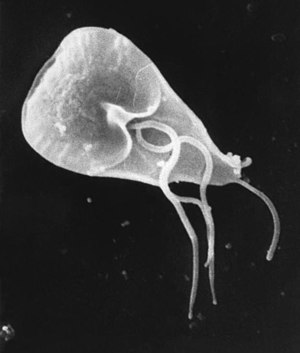| Giardiasis | |
|---|---|
| Other names | Beaver fever, giardia |
 | |
| Giardia cell viewed with scanning electron microscope | |
| Specialty | Infectious disease, gastroenterology |
| Symptoms | Diarrhea, abdominal pain, weight loss, nausea[1] |
| Usual onset | 1 to 3 weeks after exposure[2] |
| Causes | Giardia duodenalis spread mainly through contaminated food or water[1] |
| Risk factors | Hypogammaglobulinemia |
| Diagnostic method | Stool testing[1] |
| Differential diagnosis | Irritable bowel syndrome[1] |
| Prevention | Improved sanitation[1] |
| Treatment | Antiprotozoal medications |
| Medication | Tinidazole, metronidazole[1] |
| Frequency | Up to 7% (developed world), up to 30% (developing world)[1] |
Giardiasis is a parasitic disease caused by Giardia duodenalis (also known as G. lamblia and G. intestinalis).[3] Infected individuals who experience symptoms (about 10% have no symptoms) may have diarrhoea, abdominal pain, and weight loss.[1] Less common symptoms include vomiting and blood in the stool.[1] Symptoms usually begin one to three weeks after exposure and, without treatment, may last two to six weeks or longer.[4]
Giardiasis usually spreads when Giardia duodenalis cysts within faeces contaminate food or water that is later consumed orally.[1] The disease can also spread between people and through other animals.[1] Cysts may survive for nearly three months in cold water.[1] Giardiasis is diagnosed via stool tests.[1]
Prevention may be improved through proper hygiene practices.[1] Asymptomatic cases often do not need treatment.[1] When symptoms are present, treatment is typically provided with either tinidazole or metronidazole.[1] Infection may cause a person to become lactose intolerant, so it is recommended to temporarily avoid lactose following an infection.[1] Resistance to treatment may occur in some patients.[1]
Giardiasis occurs worldwide.[5] It is one of the most common parasitic human diseases.[3] Infection rates are as high as 7% in the developed world and 30% in the developing world.[1] In 2013, there were approximately 280 million people worldwide with symptomatic cases of giardiasis.[3] The World Health Organization classifies giardiasis as a neglected disease.[1] It is popularly known as beaver fever[6] in North America.
- ^ a b c d e f g h i j k l m n o p q r s t Minetti C, Chalmers RM, Beeching NJ, Probert C, Lamden K (October 2016). "Giardiasis" (PDF). BMJ. 355: i5369. doi:10.1136/bmj.i5369. PMID 27789441. S2CID 220092781.
- ^ "Giardia. General information". CDC. 21 July 2015. Archived from the original on 17 November 2016. Retrieved 17 November 2016.
- ^ a b c Esch KJ, Petersen CA (January 2013). "Transmission and epidemiology of zoonotic protozoal diseases of companion animals". Clinical Microbiology Reviews. 26 (1): 58–85. doi:10.1128/CMR.00067-12. PMC 3553666. PMID 23297259.
- ^ Cite error: The named reference
CDCSymptomswas invoked but never defined (see the help page). - ^ Cite error: The named reference
CDC_Giardiasiswas invoked but never defined (see the help page). - ^ "Giardiasis (beaver fever)". New York State Department of Health. January 2022. Archived from the original on 20 January 2022. Retrieved 27 March 2022.